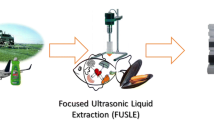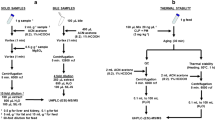Abstract
The sea lamprey (Petromyzon marinus) is a destructive invasive species in the Great Lakes. Since the 1960s, tons of the lampricide 3-trifluoromethyl-4-nitrophenol (TFM) has been applied to selected tributaries each year to eliminate or reduce sea lamprey larval populations. Therefore, the environmental impact of TFM needs to be evaluated. However, the metabolism of TFM and its mechanism of selective toxicity in sea lamprey is not yet fully understood. Based upon our previous report on the identification, synthesis, and characterization of TFM metabolites observed in liver incubates from sea lamprey and non-target fishes, we now provide a robust assay for quantifying TFM and its metabolites in fish liver tissue. This method is important for assessing bioaccumulation of TFM in the ecosystems. The compounds purified in our previous report were used to develop and validate a quantitative ultra-high-performance liquid chromatography–tandem mass spectrometry (UHPLC-MS/MS) assay for TFM and TFM metabolites formed in vivo. Several sample preparation techniques were compared, and a protein precipitation method was selected. The unavailability of stable isotopic internal standards was overcome by using a matrix matching method. After a thorough validation, this method was applied to determine the concentrations of TFM and its metabolites in fish liver tissues from animals exposed to TFM, and in the comparison between dead animals and survivors. Seven of eight expected metabolites were observed, some for the first time in vivo. Our results indicate that in vivo nitroreduction, glucuronidation, sulfation, and glutathione conjugation are involved in TFM metabolism in sea lamprey.





Similar content being viewed by others
References
Smith BR, Tibbles JJ. Sea lamprey (Petromyzon marinus) in Lakes Huron, Michigan, and Superior: history of invasion and control, 1936–78. Can J Fish Aquat Sci. 1980;37(11):1780–801.
Mullett K, Sullivan P. Sea lamprey control in the Great Lakes 2016 in Great Lakes fishery commission. 2016. http://www.glfc.org/pubs/slcp/annual_reports/ANNUAL_REPORT_2016.pdf:. Accessed 20 Feb 2017.
Lech JJ, Costrini NV. In vitro and in vivo metabolism of 3-trifluoromethyl-4-nitrophenol (TFM) in rainbow trout. Comp Gen Pharmacol. 1972;3(10):160–6.
Kawatski JA, Bittner MA. Uptake, elimination, and biotransformation of the lampricide 3-trifluoromethyl-4-nitrophenol (TFM) by larvae of the aquatic midge chironomus tentans. Toxicology. 1975;4(2):183–94.
Lech JJ, Statham CN. Role of glucuronide formation in the selective toxicity of 3-trifluoromethyl-4-nitrophenol (TFM) for the sea lamprey: comparative aspects of TFM uptake and conjugation in sea lamprey and rainbow trout. Toxicol Appl Pharmacol. 1975;31(1):150–8.
Hubert TD. Environmental fate and effects of the lampricide TFM: a review. J Geat Lakes Res. 2003;29(1):456–74.
Buhler DR, Rasmusson ME. Reduction of p-nitrobenzoic acid by fishes. Arch Biochem Biophys. 1968;124:582–95.
Bussy U, Chung-Davidson YW, Li K, Li W. Phase I and phase II reductive metabolism simulation of nitro aromatic xenobiotics with electrochemistry coupled with high resolution mass spectrometry. Anal Bioanal Chem. 2014;406(28):7253–60.
Bussy U, Chung-Davidson YW, Li K, Li W. A quantitative assay for reductive metabolism of a pesticide in fish using electrochemistry coupled with liquid chromatography tandem mass spectrometry. Environ Sci Technol. 2015;49(7):4450–7.
Bussy U, Chung-Davidson Y-W, Buchinger TJ, Li K, Smith SA, Jones DA, et al. Metabolism of a sea lamprey pesticide by fish liver enzymes. Part A. Identification and synthesis of TFM metabolites. ABC-01582-2017.
Ask K, Dijols S, Giroud C, Casse L, Frapart YM, Sari MA, et al. Reduction of nilutamide by NO synthases: implications for the adverse effects of this nitroaromatic antiandrogen drug. Chem Res Toxicol. 2003;16(12):1547–54.
Berson A, Schmets L, Fisch C, Fau D, Wolf C, Fromenty B, et al. Inhibition by nilutamide of the mitochondrial respiratory chain and ATP formation. Possible contribution to the adverse effects of this antiandrogen. J Pharmacol Exp Ther. 1994;270(1):167–76.
Abou-Khalil S, Abou-Khalil WH, Yunis AA. Differential effects of chloramphenicol and its nitrosoanalogue on protein synthesis and oxidative phosphorylation in rat liver mitochondria. Biochem Pharmacol. 1980;29(19):2605–9.
Li W, Zhang J, Tse FLST. Handbook of LC-MS bioanalysis: best practices, experimental protocols, and regulations. Wiley; 2013. p. 704.
Food and Drug Administration. Guidance for industry, bioanalytical method development. Food and Drug Administration. 2013. https://www.fda.gov/downloads/Drugs/Guidances/ucm368107.pdf. Accessed 15 Jan 2017.
Giraudeau P. Challenges and perspectives in quantitative NMR. Magn Reson Chem. 2017;55(1):61–9.
Bussy U, Giraudeau P, Tea I, Boujtita M. Understanding the degradation of electrochemically-generated reactive drug metabolites by quantitative NMR. Talanta. 2013;116:554–8.
Cohen SD, Khairallah EA. Selective protein arylation and acetaminophen-induced hepatotoxicity. Drug Metab Rev. 2010;29(1–2):59–77.
Yin H, Vergeade A, Shi Q, Zackert WE, Gruenberg KC, Bokiej M, et al. Acetaminophen inhibits cytochrome c redox cycling induced lipid peroxidation. Biochem Biophys Res Commun. 2012;423(2):224–8.
Hubert TD, Bernardy JA, Vue C, Dawson VK, Boogaard MA, Schreier TM, et al. Residues of the lampricides 3-trifluoromethyl-4-nitrophenol and niclosamide in muscle tissue of rainbow trout. J Agric Food Chem. 2005;53(13):5342–6.
Acknowledgements
This research was supported by the Great Lakes Fishery Commission. A.D.J. was supported by the USDA National Institute of Food and Agriculture Hatch project MICL-02143. The authors also thank Andrew Paul Buchinger (local angler) and Professor Kim Scribner (MSU Dept. of Fisheries & Wildlife) for the gifts of fresh blue gill livers and fresh lake sturgeon livers, respectively.
Author information
Authors and Affiliations
Corresponding author
Ethics declarations
We declare no conflict of interests. Animal tissues used in analyses were collected by staff of USGS Lake Huron Biological Station, Millersburg, MI 49759, USA. Experimental protocols involving the handling of fishes were carried out in accordance with United States federal guidelines for care and use of animals and were approved by the American Fisheries Society through the “Use of Fishes in Research Committee, 2014”.
Rights and permissions
About this article
Cite this article
Bussy, U., Chung-Davidson, YW., Buchinger, T. et al. Metabolism of a sea lamprey pesticide by fish liver enzymes part B: method development and application in quantification of TFM metabolites formed in vivo. Anal Bioanal Chem 410, 1763–1774 (2018). https://doi.org/10.1007/s00216-017-0831-7
Received:
Revised:
Accepted:
Published:
Issue Date:
DOI: https://doi.org/10.1007/s00216-017-0831-7




